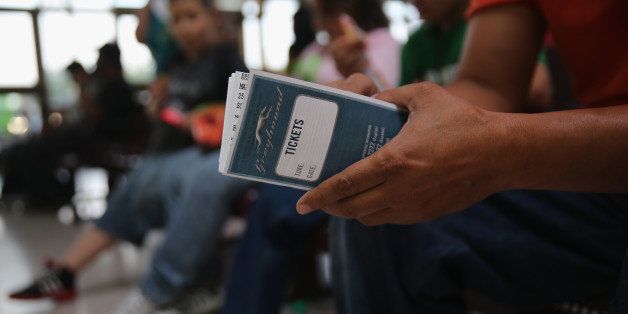
The border isn't along the border alone, it's everywhere in America.
It lives along the frayed lines of battered nerves, those of American-born citizens who fear their parents' deportation could come at any time (in many cases, grandparents of now second-generation Americans).
Over the past decade, I have traveled more than 80,000 miles by Greyhound, as part of a project to shed light on the struggles of fellow riders. As I traverse the southern routes especially, in the eyes of some riders, there is a steadied fear that says that "Even though I'm here legally, there are United States Border Patrol agents walking up this aisle asking brown people for Documentos, ID, and you never know." In dozens upon dozens of checks, I can only recall three occasions where the agents suspected a person enough to even ask him/her off the bus for questioning.
This is life along the bus routes. And it's not just on the bus, it's in fast food restaurants. Like pre-dawn at a Whataburger near Midland, Texas, where uniformed officers stopped patrons to say, "OK, I need to see them, muestrame los documentos." If you are unwealthy and Latino, especially if congregated you are, let's just say, the target audience. Don't get me wrong, the Border Patrol Agents will whip past non-Latinos on the bus and say "American?" to about 15 people in five seconds, just to get a nod.
But the border that spans the fears of immigrants everywhere is the same one barbed by wires of xenophobia -- a personal view of which I was reminded of on this visit through Midland, Texas, my mom's hometown. A boom and bust (and now boom again) town, my grandparents owned a work clothes store selling jeans and boots to oil riggers. My grandfather was a well-educated guy, graduating from MIT, but his good traits were readily eclipsed by an invective that ran like an unwanted feed. He was what one might call an equal-opportunity bigot. He, broad-brush, hated African-Americans, confounded by my mother's work as a DC City Councilmember in a majority black city, where we were raised in the public schools, at the opposite end of intolerance. He hated Latinos. "Damn s-- taking all the jobs." (He hated Jews; he was Jewish.) He wouldn't listen. It's hard to listen through a fortified wall.
Even in his later years, my grandfather held tight to the close-the-gates-behind-you version of the Statue of Liberty, the notion that proper American immigration stopped when your forbears got here. Which, in his case, would be when mine got here; and on behalf of those forbears, I beg to differ.
So this time through Midland, I had to smile when I saw that the white adobe General Clothing Store building, that had since become a Latino video store, and then a Latino Pentecostal Church, was now a gleaming first-generation-owned cell phone store.
What my grandfather didn't understand, and what I see on every bus as people of disparate backgrounds connect through a common country, is that you can't tell an American by their skin tone -- that's the whole point.